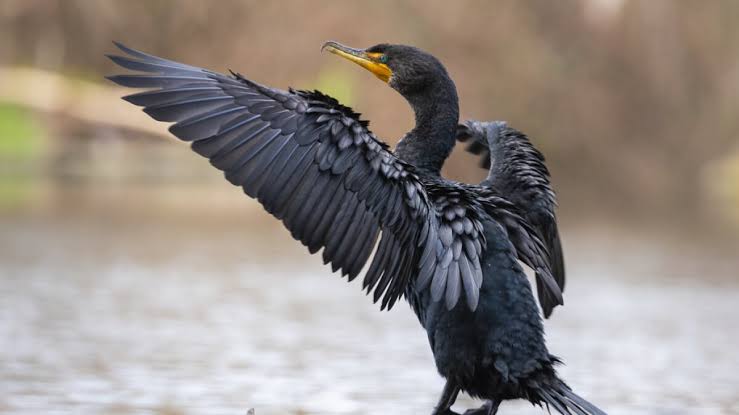cross-posted from: https://lemmygrad.ml/post/4478738
The double-crested cormorant is a member of the cormorant family of water birds. It is found near rivers and lakes and in coastal areas and is widely distributed across North America, from the Aleutian Islands in Alaska down to Florida and Mexico. Double-crested Cormorants are large waterbirds with small heads on long, kinked necks. They have thin, strongly hooked bills, roughly the length of the head. Their heavy bodies sit low in the water. has a body length of between 70 and 90 cm (28 and 35 in) long, with a wingspan of between 114 and 123 cm (45 and 48 in). Double-crested cormorants weigh between 1.2 and 2.5 kg (2.6 and 5.5 lb). Double-crested cormorants are gregarious birds that are almost always near water. Their main two activities are fishing and resting, with more than half their day spent on the latter. When at rest, a cormorant will choose an exposed spot on a bare branch or a windblown rock, and often spread its wings out, which is thought to be a means of drying their feathers after fishing. (Cormorants have less preen oil than other birds, so their feathers can get soaked rather than shedding water like a duck’s. Though this sounds like a liability, this is thought to be an adaptation that helps cormorants hunt underwater more effectively.) When swimming atop the water, cormorants ride very low, and often only their long necks are evident. Before a cormorant takes off in flight, it tends to stretch its neck in the direction it intends to fly. When it comes in for a landing, a cormorant will puff out the orange skin on its neck and, after touchdown, give a ritual little hop. If one cormorant encroaches on the space of another, such as in competition over a nest site, the cormorants will face off, stretch their necks, and open their mouths wide open to show off the blue color inside while shaking their heads and hissing at each other. To attract a mate for the season, a male cormorant will choose a nest site and then stand with his breast down and bill and tail up, showing off the crests on his head and bright colors of his neck and his eyes, grunting and slightly waving his outstretched wings. When a female arrives, she is greeted by the male opening his mouth into a gape, showing off the blue inside. Double-crested Cormorants are colonial waterbirds that seek aquatic bodies big enough to support their mostly fish diet. However, they may roost and form breeding colonies on smaller lagoons or ponds, and then fly up to 40 miles to a feeding area. In addition to fishing waters, cormorants need perching areas for the considerable amount of time they spend resting each day. A cormorant’s diet is almost all fish, with just a few insects, crustaceans, or amphibians. They eat a wide variety of fish (more than 250 species have been reported), and they have impressive fishing technique: diving and chasing fish underwater with powerful propulsion from webbed feet. The tip of a cormorant’s upper bill is shaped like a hook, which is helpful for catching prey. When cormorants happen to catch a crustacean like a crayfish, they exhibit a little flair in eating it—hammering the prey on the water to shake its legs off, then flipping it in the air and catching it headfirst for easy swallowing. Gulls, crows, blue jays, raccoons, red foxes and coyotes prey on cormorant eggs and chicks. The Double-crested Cormorant makes deep, guttural grunts that sound a bit like an oinking pig. They grunt when taking off or landing, or during mating or aggressive displays, but otherwise are generally silent. Here is a link so you can listen to this bird too.

My favorite bird. If I had creature powers this is what I’d choose
Cormorants crack me up. I love em. Not exactly the most graceful takeoffs from water.